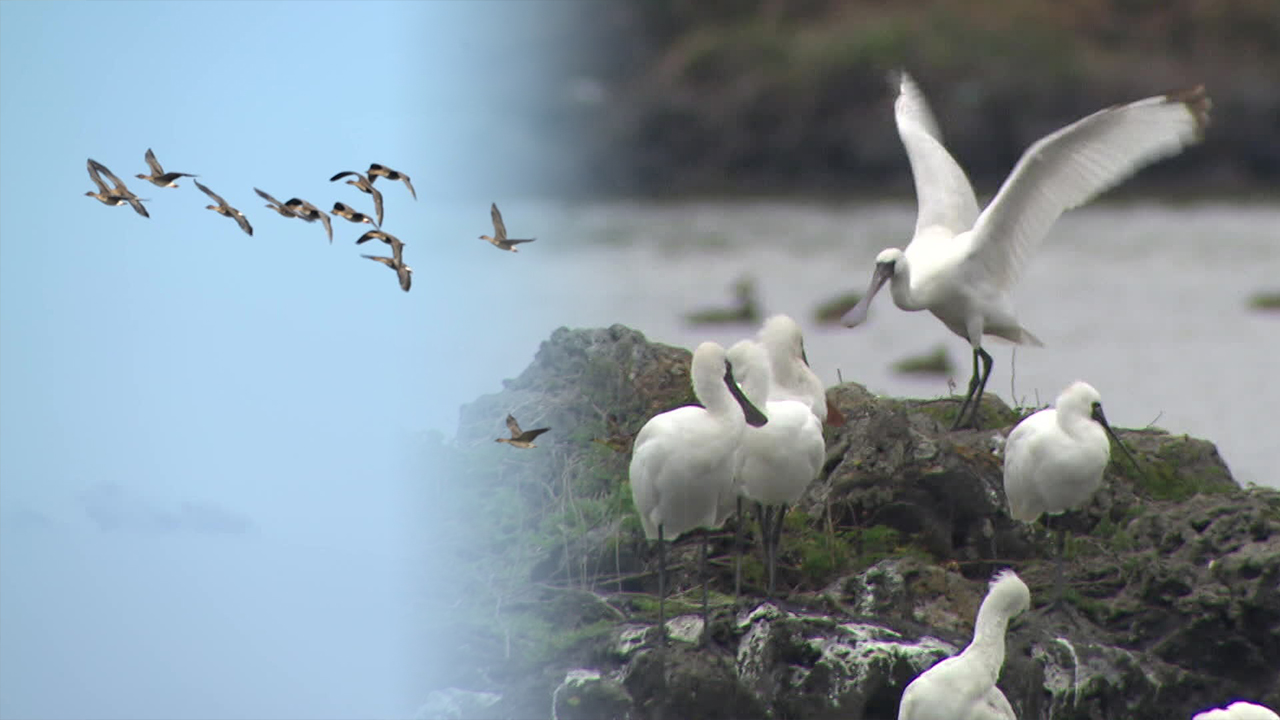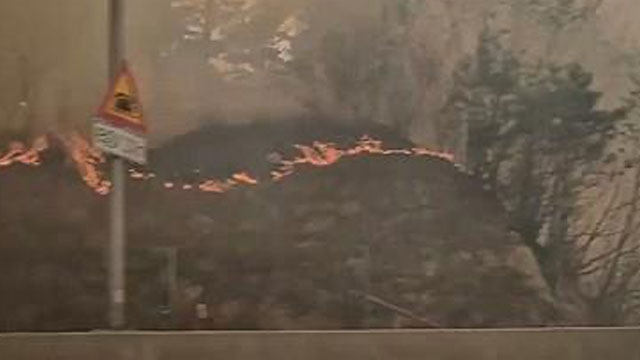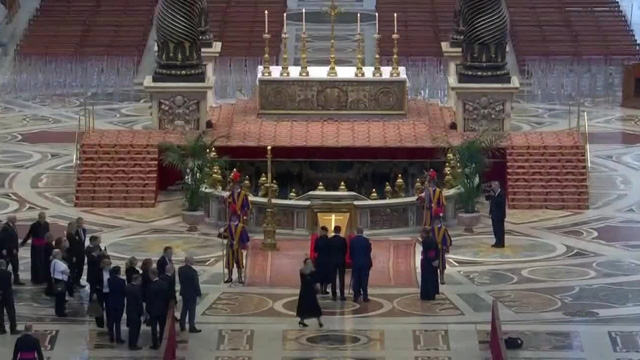Jeju's upcoming second airport also faces bird strike risks
입력 2025.01.01 (05:48)
읽어주기 기능은 크롬기반의
브라우저에서만 사용하실 수 있습니다.
[Anchor]
Now, let's go to Jeju.
There are numerous migratory bird habitats around the site planned for the second airport in Seogwipo City.
The Ministry of Land, Infrastructure and Transport has stated that it will prepare alternative habitats, but there are strong concerns arising from this recent disaster.
This is Kang In-hee reporting.
[Report]
A resting place for the natural monument and internationally endangered species, the black-faced spoonbill.
This migratory bird habitat is located 8km away from the planned site of the second airport in Jeju.
There are four migratory bird habitats within a 13km radius of the second airport construction site.
Over 140 species of birds and approximately 56,000 individuals have been observed.
Bird strike incidents at Jeju Airport occur about 20 times a year, but a strategic environmental impact assessment last March pointed out that the risk of bird strikes at the second airport could be up to eight times higher.
[Son Myung-hwan/Professor of Aviation Maintenance at Sehan University: "(If the area around the planned airport site) is a route that birds can travel, it is clearly a factor that poses a risk to aircraft safety, and serious review is definitely necessary."]
The Ministry of Land, Infrastructure and Transport plans to prepare alternative habitats to reduce the risk of bird strikes.
However, BirdLife International, an international bird conservation organization, has warned about the risk of bird strikes at Jeju's second airport site, pointing out that there are almost no successful cases of alternative habitats.
[Choi Chang-yong/Professor of Forest Science at Seoul National University: "When we talk about alternative habitats, we are only considering ducks, geese, and gulls. However, we must take into account that there could be many more risk factors than that...."]
The International Civil Aviation Organization, a UN agency, also recommends avoiding migratory bird routes and bird-preferred areas when constructing new airports, so it seems that the controversy surrounding the construction of the second airport in Jeju will resurface due to this recent disaster.
This is KBS News, Kang In-hee.
Now, let's go to Jeju.
There are numerous migratory bird habitats around the site planned for the second airport in Seogwipo City.
The Ministry of Land, Infrastructure and Transport has stated that it will prepare alternative habitats, but there are strong concerns arising from this recent disaster.
This is Kang In-hee reporting.
[Report]
A resting place for the natural monument and internationally endangered species, the black-faced spoonbill.
This migratory bird habitat is located 8km away from the planned site of the second airport in Jeju.
There are four migratory bird habitats within a 13km radius of the second airport construction site.
Over 140 species of birds and approximately 56,000 individuals have been observed.
Bird strike incidents at Jeju Airport occur about 20 times a year, but a strategic environmental impact assessment last March pointed out that the risk of bird strikes at the second airport could be up to eight times higher.
[Son Myung-hwan/Professor of Aviation Maintenance at Sehan University: "(If the area around the planned airport site) is a route that birds can travel, it is clearly a factor that poses a risk to aircraft safety, and serious review is definitely necessary."]
The Ministry of Land, Infrastructure and Transport plans to prepare alternative habitats to reduce the risk of bird strikes.
However, BirdLife International, an international bird conservation organization, has warned about the risk of bird strikes at Jeju's second airport site, pointing out that there are almost no successful cases of alternative habitats.
[Choi Chang-yong/Professor of Forest Science at Seoul National University: "When we talk about alternative habitats, we are only considering ducks, geese, and gulls. However, we must take into account that there could be many more risk factors than that...."]
The International Civil Aviation Organization, a UN agency, also recommends avoiding migratory bird routes and bird-preferred areas when constructing new airports, so it seems that the controversy surrounding the construction of the second airport in Jeju will resurface due to this recent disaster.
This is KBS News, Kang In-hee.
■ 제보하기
▷ 카카오톡 : 'KBS제보' 검색, 채널 추가
▷ 전화 : 02-781-1234, 4444
▷ 이메일 : kbs1234@kbs.co.kr
▷ 유튜브, 네이버, 카카오에서도 KBS뉴스를 구독해주세요!
- Jeju's upcoming second airport also faces bird strike risks
-
- 입력 2025-01-01 05:48:07

[Anchor]
Now, let's go to Jeju.
There are numerous migratory bird habitats around the site planned for the second airport in Seogwipo City.
The Ministry of Land, Infrastructure and Transport has stated that it will prepare alternative habitats, but there are strong concerns arising from this recent disaster.
This is Kang In-hee reporting.
[Report]
A resting place for the natural monument and internationally endangered species, the black-faced spoonbill.
This migratory bird habitat is located 8km away from the planned site of the second airport in Jeju.
There are four migratory bird habitats within a 13km radius of the second airport construction site.
Over 140 species of birds and approximately 56,000 individuals have been observed.
Bird strike incidents at Jeju Airport occur about 20 times a year, but a strategic environmental impact assessment last March pointed out that the risk of bird strikes at the second airport could be up to eight times higher.
[Son Myung-hwan/Professor of Aviation Maintenance at Sehan University: "(If the area around the planned airport site) is a route that birds can travel, it is clearly a factor that poses a risk to aircraft safety, and serious review is definitely necessary."]
The Ministry of Land, Infrastructure and Transport plans to prepare alternative habitats to reduce the risk of bird strikes.
However, BirdLife International, an international bird conservation organization, has warned about the risk of bird strikes at Jeju's second airport site, pointing out that there are almost no successful cases of alternative habitats.
[Choi Chang-yong/Professor of Forest Science at Seoul National University: "When we talk about alternative habitats, we are only considering ducks, geese, and gulls. However, we must take into account that there could be many more risk factors than that...."]
The International Civil Aviation Organization, a UN agency, also recommends avoiding migratory bird routes and bird-preferred areas when constructing new airports, so it seems that the controversy surrounding the construction of the second airport in Jeju will resurface due to this recent disaster.
This is KBS News, Kang In-hee.
Now, let's go to Jeju.
There are numerous migratory bird habitats around the site planned for the second airport in Seogwipo City.
The Ministry of Land, Infrastructure and Transport has stated that it will prepare alternative habitats, but there are strong concerns arising from this recent disaster.
This is Kang In-hee reporting.
[Report]
A resting place for the natural monument and internationally endangered species, the black-faced spoonbill.
This migratory bird habitat is located 8km away from the planned site of the second airport in Jeju.
There are four migratory bird habitats within a 13km radius of the second airport construction site.
Over 140 species of birds and approximately 56,000 individuals have been observed.
Bird strike incidents at Jeju Airport occur about 20 times a year, but a strategic environmental impact assessment last March pointed out that the risk of bird strikes at the second airport could be up to eight times higher.
[Son Myung-hwan/Professor of Aviation Maintenance at Sehan University: "(If the area around the planned airport site) is a route that birds can travel, it is clearly a factor that poses a risk to aircraft safety, and serious review is definitely necessary."]
The Ministry of Land, Infrastructure and Transport plans to prepare alternative habitats to reduce the risk of bird strikes.
However, BirdLife International, an international bird conservation organization, has warned about the risk of bird strikes at Jeju's second airport site, pointing out that there are almost no successful cases of alternative habitats.
[Choi Chang-yong/Professor of Forest Science at Seoul National University: "When we talk about alternative habitats, we are only considering ducks, geese, and gulls. However, we must take into account that there could be many more risk factors than that...."]
The International Civil Aviation Organization, a UN agency, also recommends avoiding migratory bird routes and bird-preferred areas when constructing new airports, so it seems that the controversy surrounding the construction of the second airport in Jeju will resurface due to this recent disaster.
This is KBS News, Kang In-hee.
-
-

강인희 기자 inhee@kbs.co.kr
강인희 기자의 기사 모음
-
이 기사가 좋으셨다면
-
좋아요
0
-
응원해요
0
-
후속 원해요
0















이 기사에 대한 의견을 남겨주세요.